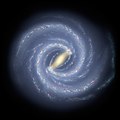Leo I (dwarf galaxy)
| Leo I | |
|---|---|
| Apparent magnitude (V) | 11.2[1] |
| Absolute magnitude (V) | −12.0[4] |
| Characteristics | |
| Type | E;dSph[1] |
| Mass | (2.0 ± 1.0) × 107 M☉ |
| Size | 2000 ly[5] |
| Apparent size (V) | 9.8′ × 7.4′[1] |
| Notable features | Milky Way satellite |
| Other designations | |
| UGC 5470,[1] PGC 29488,[1] DDO 74,[1] A1006,[1] Harrington-Wilson #1,[1] Regulus Dwarf[1] | |
Leo I is a dwarf spheroidal galaxy in the constellation Leo. At about 820,000 light-years distant, it is a member of the Local Group of galaxies and is thought to be one of the most distant satellites of the Milky Way galaxy. It was discovered in 1950 by Albert George Wilson on photographic plates of the National Geographic Society – Palomar Observatory Sky Survey, which were taken with the 48-inch Schmidt camera at Palomar Observatory.[6][7]
Visibility
Leo I is located only 12
The proximity of Regulus and the low surface brightness make it a real challenge to observe. Medium-sized amateur telescopes (15 cm or more) and a dark sky appear to be required for a sighting. But some reports of April 2013 tell that one observer with an 11 cm mini Dobson and even a refractor as small as 7 cm f/10 has sighted Leo I under very dark sky conditions.[8]
Mass
The measurement of radial velocities of some bright red giants in Leo I have made possible to measure its mass. It was found to be at least (2.0 ± 1.0) × 107 M☉. The results are not conclusive, and do not exclude or confirm the existence of a large dark matter halo around the galaxy. However, it seems to be certain that the galaxy does not rotate.[7]
A kinematic study of Leo I could not place much constraints on dark matter, but suggested the presence of a black hole of three million solar masses in the center of the galaxy. This would be significant, as it would be the first time this has been done with a dwarf spheroidal galaxy.[9] A black hole of three million solar masses is comparable to the mass of the Milky Way's black hole, Sagittarius A*.[5] However, another study could not confirm this, suggesting at most an intermediate-mass black hole of a few 105 solar masses.[10]
It has been suggested that Leo I is a tidal debris stream in the outer halo of the Milky Way. This hypothesis has not been confirmed, however.[7]
Star formation
Typical to a dwarf galaxy, the
References
- ^ a b c d e f g h i j k l "NASA/IPAC Extragalactic Database". Results for Leo I. Retrieved 2006-11-29.
- doi:10.1086/382905.
- S2CID 120973010.
- ^ .
- ^ a b Pultarova, Tereza (2021-12-03). "Giant black hole inside a tiny satellite galaxy of our Milky Way defies explanation". Space.com. Retrieved 2021-12-03.
- ^ a b "Leo I". SEDS Messier Database. Retrieved 2006-05-15.
- ^ ISBN 0-521-65181-6.
- ^ "Faint Fuzzy Observations". Archived from the original on 2014-03-24. Retrieved 2014-03-24.
- S2CID 243798608.
- .
- S2CID 1805423.
External links
- Leo I (dwarf galaxy) on
- NASA Astronomy Picture of the Day: Leo I (3 October 1999)
- SEDS page on Leo I

